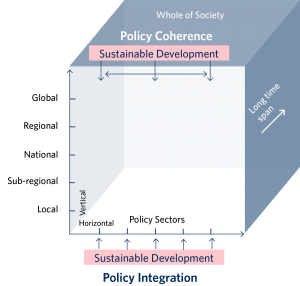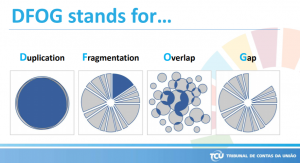Sustainable development combines economic, social and environmental aspects. It requires a high level of policy coherence from governance – that different actors work in the same direction towards common goals. The UN Sustainable Development Goals have given a boost to political coherence. Tools for assessing policy coherence are also becoming available.
Policy coherence is a broad concept. It can be understood as a principle by which government seeks to reduce conflicts and strengthen the cumulative effect of its actions in order to achieve jointly agreed objectives. The principle is brought into practice by policy integration. It could be defined as mainstreaming where different administrative sectors strive to take commonly agreed objectives into account in their own activities.
In the fight against the loss of biodiversity, policy coherence would mean that the prevention of biodiversity loss is a commonly adopted objective and that there are effective mechanisms to manage potential conflicts. Policy integration, in turn, would mean in more concrete terms that biodiversity is not only the responsibility of environmental governance but that the governance of the agricultural and forestry sector also integrates it into the agricultural and forestry policy. In practice, however, the concepts are often used without distinction, and frequently the only term used is “policy coherence”.
Horizontal integration refers to mainstreaming objectives between different policy sectors. Vertical integration, in turn, would mean addressing the biodiversity loss at all levels of government from local to sub-regional and national level and further to regional and global level. When policy coherence is linked with the intergenerational aspect of sustainable development and the fact that it concerns the whole of society, it can be illustrated by the following figure.

Conflicting and overlapping steering measures undermine effectiveness
Why does the lack of political coherence pose a problem? An example of this is the different forms of support that are conflicting from the perspective of climate policy. Their significance for central government finances appeared in the climate-related audits that the National Audit Office conducted at the beginning of the 2010s. The amount of tax subsidies that were contrary to climate actions had not yet been assessed at the time. The question arose whether the left hand of the state knows what the right hand is doing: on the one hand, tax revenue was used to reduce emissions and, on the other hand, these measures were undermined by subsidies to fossil fuels.
Later on, calculations have been made in Finland on subsidies with an opposite effect to that of climate actions. The calculations show that the amount of these subsidies exceeds the budget’s climate expenditure. Although there will always be many partly competing objectives in society, it is not appropriate from the perspective of the efficiency, economy and effectiveness of central government finances to fund actions that undermine each other’s effects.
There are also overlapping forms of support in climate policy that have an effect on each other. For example, increasing the use of renewable energy and energy efficiency at EU level has an impact on the emissions trading sector. Another problem that has been identified is the promotion of renewable energy by measures that endanger the cultivation of food crops in the global South. At present, there is growing concern over whether the measures to reduce emissions will increase the biodiversity loss.
How can we promote policy coherence instead? The NAOF has recently looked into the possibilities of phenomenon-based budgeting and recognized it as a way of promoting policy coherence. In phenomenon-based budgeting, the budget is based on a phenomenon such as climate, children or sustainable development. The European Supreme Audit Institutions (SAIs) are particularly interested in the sustainability of the coronavirus recovery packages and the consistency with which they support the transition of societies towards a carbon-neutral economy.
Tools for assessing policy coherence
The OECD has addressed Policy Coherence for Development (PCD) since the 1990s. It aims at integrating developing country issues into the work of all administrative sectors. Following the 2030 Agenda, the OECD’s work has been targeted at Policy Coherence for Sustainable Development (PCSD), on which it has also issued a recommendation (pdf). The recommendation encourages states to support policy coherence by drawing up a strategic vision for implementing the 2030 Agenda, by creating institutional mechanisms and by developing tools that make it easier to assess domestic, transboundary and long-term impacts of policies.
There is a lot of talk about policy coherence today, especially in the context of the UN’s Sustainable Development Goals (SDGs). Coherence is one of the tools for implementing the 2030 Agenda, target 17.14. It seems to be more difficult to determine how to assess it in practice. However, there are already tools available for this.
The OECD has developed a tool for assessing states’ institutional capacity to pursue a coherent policy from the perspective of sustainable development. The Stockholm Environment Institute (SEI) has, in turn, been developing a tool for coherent implementation of the 2030 Agenda. It makes it easier to assess the conflicts and synergies between the SDGs and to prioritize targets and organize cooperation.
Based on the work of the SAI of the United States, the SAI of Brazil has developed a model for assessing the duplication, fragmentation, overlap and gaps of central government functions. The model helps to identify the impacts of incoherent functions and determine how to improve efficiency and manage problems. It was found in Brazil that policy coherence is weakened, for example, by the fact that the state allocates subsidies to organic farming while granting tax relief on the use of pesticides.

Links between environmental policy and social and health policy are not recognized
From the perspective of policy coherence, it is important to recognize links between issues, regardless of the administrative sector under whose responsibility they fall. By auditing the implementation of the SDGs, we can obtain a good overview of the links between different policies. This is what the SAI of Canada has found. The SAI of the United Kingdom, in turn, finds it important to consider the systemic perspective and the feasibility of complex programmes.
The guiding principle of the 2030 Agenda is leaving no one behind in sustainable development. This may be forgotten if the focus is only on analysing the relations between the sustainable development subgoals. However, this principle is essentially related to the just transition to a carbon-neutral society and how the transition to a carbon-neutral economy treats different population groups.
According to Taina Rintala, Performance Audit Counsellor at the NAOF, the social and health policy objectives are closely linked with the activities and objectives of other sectors (pdf). Regardless of this, the links between, for example, environmental policy and social and health policy are seldom recognized. They could be taken into consideration when the impacts of laws are assessed: environmental impacts should be considered in legislative projects falling under social and health policy, and vice versa.
Identifying conflicts and synergies and responding to them can increase societal impact
Discussions on governance and research have returned to policy coherence and the mainstreaming of policy supporting the SDGs. Around 10–15 years ago, coherence was mainly discussed in connection with environmental and climate policy, whereas today attention is paid more broadly to how it is reflected in interlinked sectors and multi-dimensional policy problems. The UN 2030 Agenda and the SDGs have increased interest in policy coherence. Today, there is also a growing interest in the development of concrete methods to increase coherence.
These methods will hopefully help policy-makers and evaluators to better understand the links between different policy objectives and administrative sectors. Although there will always be partly conflicting policy objectives in society, it is possible to resolve conflicts more effectively by identifying them and making them visible. However, when the aim is to improve the societal impact of governance, it is not only conflicts that play a key role; it is as important to detect and utilize hidden synergies.
Vivi Niemenmaa (NAOF) and Paula Kivimaa (SYKE)
Paula Kivimaa works as Research Professor at the Finnish Environment Institute (SYKE). In 2010–2011, she worked at the NAOF in an audit project related to the implementation of the Finnish climate and energy strategy.

